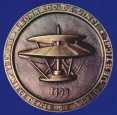
""
SCHWEIZER
AIRCRAFT CORP.
|
SCHWEIZER 269B |

|
|
|
Una
encuesta llevada a cabo en 1955 por Hughes Tool Company, una empresa que
actuaba en diferentes áreas de la industria aeronáutica, le reveló
que se encontraba en el mejor momento de ofrecer un helicóptero liviano
biplaza. La división de aeronaves comenzó a construir el Modelo 269
en septiembre de 1955. Este helicóptero constaba de un cockpit
totalmente acristalado con capacidad de dos personas lado a lado, un
fuselaje abierto y un rotor tripala totalmente articulado. El prototipo
voló por primera vez en octubre de 1956, pero no fue hasta 1960 que
Hughes decidió desarrollar la aeronave produciendo una versión
mejorada, el Modelo 269 A, la cual era mucho mas aerodinámica y
con refinamientos estructurales. Esta aeronave era ideal para el uso
policial del momento. Se construyeron 314 aeronaves de este modelo. El Hughes
269A comparado con el modelo
anterior tenía un cockpit mas compacto, el tren de aterrizaje curvado
hacia arriba en la parte frontal y disponía de dos pequeñas ruedas
para ser manejado en tierra. Constaba además de un pequeño
estabilizador trasero. El proyecto fue enviado al US Army, el cual ordenó
cinco prototipos, designándolo como YHO-2-HU, para evaluación
en Fort Rucker. El Army le envió a la Hughes algunas recomendaciones
que serían adaptadas para comenzar la producción. En el verano de
1964, el Army lo eligió como entrenador primario y ordenó 20 unidades,
designadas TH-55A OSAGE. Dos ordenes de compra posteriores
llevaron a la producción a un total de OSAGE a 396 unidades. En
1967, otra orden fue recibida, elevando el total a 796, finalizando las
entregas en marzo de 1969. La versión
triplaza del 269 (designada posteriormente Modelo 300) fue
muy exitosa en el extranjero en la versión para fumigar, pero fue
vendida también a operadores y fuerzas armadas de varios países. La
versión final denominada 300C constaba de un motor mas potente y
un rotor principal diferente, pudiendo transportar un 45 por ciento mas
de carga que los primeros modelos. El Hughes
300 fue construido bajo licencia por Kawasaki en Japón y por
Breda-Nardi en Italia. En ambos países las partes fueron inicialmente
importadas desde los Estados Unidos, iniciándose la producción total
posteriormente. En 1983 la producción de los derechos en USA fue
vendida a la Schweizer Aircraft Company de New York. |
|
|
|
A
market survey carried out in 1955 by the Hughes Tool Company, an
American company active in many areas of the aeronautical industry,
showed that the time was ripe for a low-cost lightweight two-seat
helicopter. The Aircraft division began building the Model 269 in
September 1955. This helicopter had a fully-glazed cockpit with
side-by-side accommodation for two, an open-framework fuselage and a
three-blade articulated rotor. The prototype flew in October 1956, but
it was not until 1960 that Hughes decided to develop this machine
further by producing an improved version, the Model 269A, to
which many aerodynamic and structural refinements had been made. The
aircraft also proved ideal for police work and other duties. About 20 a
month were being produced by mid 1963 and by spring 1964, 314 had been
built. The Hughes 269A was more interesting than the
earlier prototype from a structural point of view. It had a redesigned,
more compact cockpit and a steel tube fuselage. The landing skids were
curved upwards at the front, and two small wheels could be added to
facilitate ground handling. There was a small, asymmetrical butterfly
tail unit. The project was submitted to the US Army who ordered five,
designated YHO-2-HU, for evaluation at Fort Rucker, and a number
of recommendations by Army engineers were adopted by Hughes to improve
the design and establish production. In summer 1964, the Army chose it
as a primary trainer and ordered 20, designated TH-55A Osage. Two
subsequent orders brought the total number of the Osage in 1965
to 396. In 1967, another order was received, bringing the total to 792.
Deliveries ended in March 1969. The various two-three seat versions of the 269
(later redesignated Model 300) were very successful abroad, notably
the agricultural version, but they were also sold to air forces and
operators in Algeria, Brazil, Colombia, Ghana, Haiti, India, Kenya,
Nicaragua, Sierra Leone, Spain and Sweden. The final variant, the 300C
which had a more powerful engine and a new main rotor, could carry 45 per
cent more payload than the first models. The Hughes 300 has been built under license by
Kawasaki in Japan and by Breda-Nardi in Italy. In both countries, the
parts were initially imported from the United States with full-scale
production following later. In 1983 the US production rights were sold to
the Schweizer Aircraft Company in New York. G.Apostolo "The Illustrated Encyclopedia of Helicopters", 1984 |
|
|
|
Characteristics |
Information |
Characteristics |
Information |
| First
Flight Primer Vuelo |
19?? |
Engine Motor |
1
Lycoming |
| Seating
Capacity Plazas |
1 / 2 |
Power Potencia |
180 HP |
| Empty
Weight Peso Vacío |
958 Lb |
Hover
Ceiling O.G.E. Estacionario O.G.E |
5800 Ft |
| Maximum
Weight Peso Máximo |
1670 Lb |
Hover
Ceiling I.G.E. Estacionario I.G.E |
7700 Ft |
| Vel.
Cruise Vel. crucero |
60 Kts |
Service
Ceiling Techo de Servicio |
Fts |
| V.N.E. V.N.E |
76 Kts |
Maximum
Range (Std) Alcance (Std) |
260 NM |
Copyright © 1999 / 2003